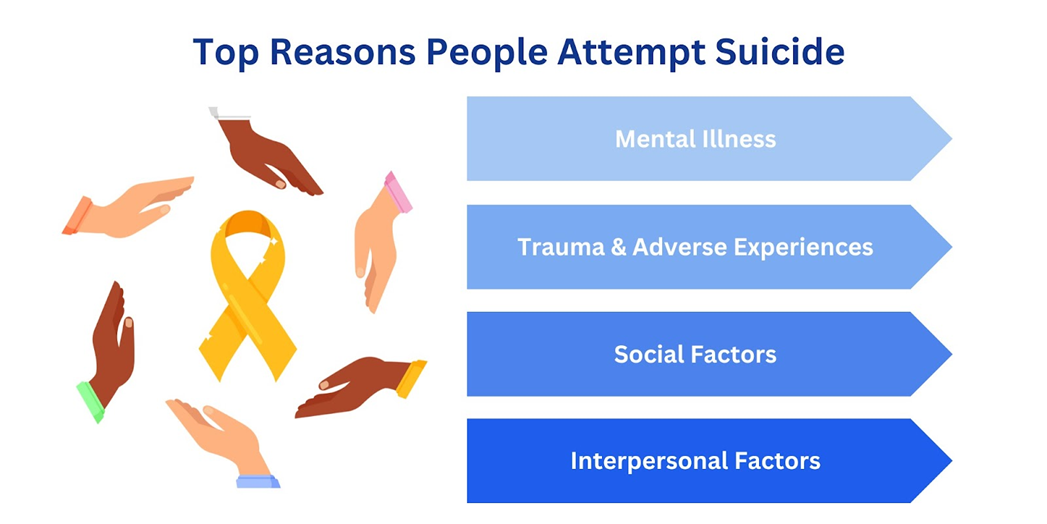
Top Reasons People Attempt Suicide Even When They Seem to Be Okay

Why Do People Commit Suicide?
Suicide is a complex and deeply personal issue that continues to puzzle both researchers and individuals affected by its consequences. It’s a stark reminder of the struggles many face behind closed doors, often hidden from the outside world until it’s too late. While there’s no one-size-fits-all explanation for why people take their own lives, there are common threads woven through the narratives of those who have experienced such despair.
What Are The Reasons Behind Suicide Attempts?
Mental Illness
One of the primary factors contributing to suicide is mental illness. Conditions like
- depression,
- bipolar disorder,
- schizophrenia, and
- substance abuse
Trauma and Adverse Life Experiences
Trauma and adverse life experiences also play a significant role in suicide risk. Whether its
- childhood abuse,
- loss of a loved one, or
- ongoing societal discrimination,
Social Factors
Several social factors are equally responsible for suicidal attempts. Factors such as
- financial strain,
- relationship problems, and
- societal pressures
Interpersonal Factors
One of the most significant reasons behind the suicidal attempts are the Interpersonal factors. The breakdown of interpersonal relationships or the fear of social judgement can intensify feelings of loneliness and alienation. Hence, for some individuals, suicide may appear to be a logical choice when confronted with overwhelming anguish. It’s not a hasty decision but rather the result of enduring inner turmoil. Despite the common belief that suicide is a self-centered act, it often stems from a longing to escape suffering and attain peace.
Understanding the reasons behind suicide necessitates a deep exploration of human psychology and societal dynamics. It underscores the significance of empathy, assistance, and the availability of mental health services.
By tackling the root causes that lead to suicide, we can strive towards building a society where each person feels appreciated, supported, and optimistic about what lies ahead.
What Are The Strategies for Suicide Prevention?
Suicide, a profound and devastating outcome of mental anguish, remains a critical public health concern. However, amidst the darkness, there are rays of hope. Through proactive measures and community support, we can work together to prevent suicide and save lives. Here are some strategies for suicide prevention
- Promote Mental Health Awareness:
- Provide Access to Mental Health Services:
- Train Gatekeepers:
- Create Supportive Environments:
- Address Risk Factors:
- Limit Access to Lethal Means:
- Raise Awareness:
- Offer Peer Support:
- Follow-Up and Aftercare:
- Crisis Hotlines and Helplines:
Education is key in breaking down the stigma surrounding mental illness. By fostering open conversations and providing accurate information about mental health, we can empower individuals to recognize the signs of distress and seek help when needed.
Ensure that mental health services are readily available and accessible to all individuals. This includes counselling, therapy, and psychiatric care. Telehealth options can also expand access to care for those in remote or underserved areas.
Equip frontline professionals, such as healthcare providers, educators, and first responders, with the skills to identify and respond to individuals at risk of suicide. Training in suicide prevention techniques can help these gatekeepers intervene effectively and connect individuals with appropriate resources.
Foster a culture of compassion and support in schools, workplaces, and communities. Encourage open dialogue about mental health, provide opportunities for social connection, and promote resilience-building activities.
Identify and address underlying risk factors associated with suicide, such as mental illness, substance abuse, trauma, and social isolation. Provide targeted interventions and support services tailored to the needs of at-risk populations.
Implement strategies to reduce access to lethal means of suicide, such as firearms, medications, and toxic substances. This may include safe storage practices, voluntary surrender programs, and restrictions on access to potentially harmful substances.
Increase public awareness about the warning signs of suicide and the resources available for support and intervention. Utilize media campaigns, community events, and online platforms to disseminate information and encourage help-seeking behavior.
Peer support programs, such as support groups and peer counseling, can provide valuable connections and understanding to individuals struggling with suicidal thoughts or behaviors. Peer support offers a sense of belonging and validation, reducing feelings of isolation and hopelessness.
Ensure that individuals who have experienced a suicidal crisis receive appropriate follow-up care and support. This may include ongoing therapy, medication management, and safety planning to reduce the risk of future suicide attempts.
Promote the availability of crisis hotlines, helplines, and online chat services for individuals in crisis. These services offer immediate support and intervention for those experiencing suicidal thoughts or feelings of distress. By implementing these strategies and fostering a culture of care and support, we can make meaningful strides in preventing suicide and saving lives. Together, we can build a lifeline of hope for those in crisis and create a world where every individual feels valued, supported, and connected. If you or someone you know is struggling, please reach out for help. You are not alone, and there is hope.
Mental Health Services in India
In recent years, there has been a growing recognition of the importance of mental health in India. Despite progress, significant gaps persist in the availability and accessibility of mental health services across the country. Here’s a closer look at the landscape of mental health services in India:
- Government Initiatives:
- Primary Healthcare Integration:
- Psychiatric Facilities:
- Counseling and Therapy Services:
- Telemedicine and Online Counseling:
- Community-Based Interventions:
- Workplace Mental Health Programs:
- Challenges and Opportunities:
The Government of India has taken steps to address mental health needs through initiatives such as the National Mental Health Program (NMHP). This program aims to provide accessible, affordable, and quality mental health care to all citizens, with a focus on community-based interventions and awareness campaigns.
Efforts are underway to integrate mental health services into primary healthcare settings to improve accessibility and reduce stigma. This includes training primary care providers to identify and manage common mental health conditions and providing psychosocial support at the grassroots level.
India has a network of psychiatric hospitals and mental health institutes that provide specialized care for individuals with severe mental illnesses. However, these facilities are often concentrated in urban areas, leaving rural and remote populations underserved.
Private counseling centers, psychotherapy clinics, and non-profit organizations offer counseling and therapy services for a range of mental health concerns. These services cater to diverse populations and provide support for issues such as depression, anxiety, trauma, and relationship problems.
With the increasing use of technology, telemedicine platforms, and online counseling services are emerging as viable options for delivering mental health care, particularly in remote areas. These platforms connect individuals with qualified mental health professionals via video calls, chats, or phone consultations.
Non-governmental organizations (NGOs) and community-based organizations play a crucial role in promoting mental health awareness and providing support to vulnerable populations. They offer outreach programs, support groups, and psychosocial interventions to address the needs of marginalized communities.
Employers are recognizing the importance of mental health in the workplace and implementing initiatives to support employee well-being. This includes employee assistance programs, mental health awareness training, and stress management workshops.
Despite these efforts, several challenges persist, including a shortage of mental health professionals, inadequate funding, and stigma surrounding mental illness. However, there are opportunities for improvement through increased investment in mental health infrastructure, training of healthcare providers, and public awareness campaigns.
Conclusion
In conclusion, while mental health services in India have made strides in recent years, there is still much work to be done to ensure equitable access to quality care for all. By addressing existing challenges and building on existing initiatives, we can create a more inclusive and supportive mental health system that meets the diverse needs of India’s population.
Avail the best counsellors near you to support your mental health at
https://mpowerminds.com/contact
image credit : freepik

How Psychotherapy Helps in Late-Life Depression And Anxiety: A Path to Healing, Hope, And Healthy Aging
How Social Isolation Impacts Geriatric Mental Health? How to Reverse It?

